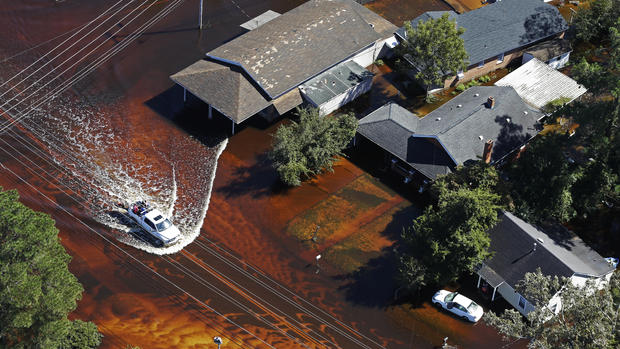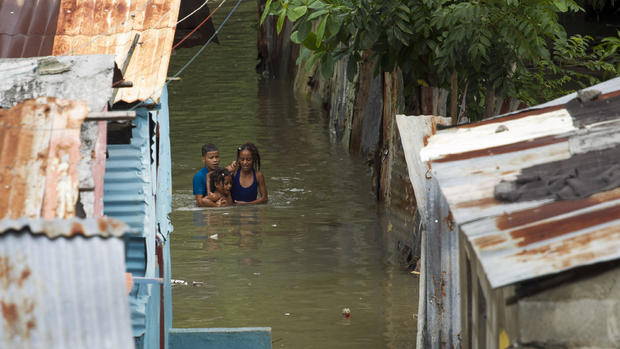Resident of Les Cayes in Haiti: “It’s like a bulldozer just passed by”
PETIT-GOAVE, Haiti -- Hurricane Matthew slammed into Haiti’s southwestern tip with howling, 145 mph winds Tuesday, tearing off roofs in the poor and largely rural area, uprooting trees and leaving rivers bloated and choked with debris. At least 11 deaths were blamed on the storm during its week-long march across the Caribbean.
Forecasters said around 8 p.m. EST the eye of Hurricane Matthew has made landfall near the eastern tip of Cuba.
The easternmost points in Cuba’s easternmost province Guantanamo are still getting assaulted by hurricane force winds and rain, reported CBS News’ Portia Siegelbaum from Havana. Baracoa is facing the most difficult situation because of its antiquated drainage system and rivers that are overflowing adding to the flooding from high waves and storm surge. Earlier in the day, wind gusts ripped off the roof of a small tourist hotel, “La Rusa,” located right on the coast in Baracoa.
A resident of Baracoa, Barbaro Abad, spoke via cell phone to Cuban TV. Abad called the situation “very difficult.” Houses next door and behind him have collapsed. He said he can hear the wind and rain pounding on the roof and walls of his home, making them tremble.
Hurricane Matthew swept away the coastal town of Les Cayes in Haiti.
Resident George Elie told CBS News correspondent Mark Strassmann that it was devastating.
“Whole houses. Everything is gone.... It’s like a bulldozer just passed by... I can tell you it’s a big disaster...” he said.
Forecasters said Matthew could hit Florida toward the end of the week and push its way up the East Coast over the weekend. The forecast triggered a rush by Americans to stock up on food, gasoline and other emergency supplies.
The dangerous Category 4 storm -- at one point the most powerful hurricane in the region in nearly a decade -- blew ashore around dawn in the poorest country in the Western Hemisphere, hitting a corner of Haiti where many people live in shacks of wood or concrete blocks. It unloaded heavy rain as it swirled on toward a lightly populated part of Cuba and the Bahamas.
Damage in the hardest-hit part of Haiti appeared to be widespread, but because of spotty communications, blocked roads and washed-out bridges, the full extent was not immediately clear. Nor was the number of deaths.
The country’s Civil Protection Agency said many homes were damaged or destroyed.

“It’s the worst hurricane that I’ve seen during my life,” said Fidele Nicolas, a civil protection official in Nippes, just east of where Matthew came ashore. “It destroyed schools, roads, other structures.”
At least three deaths were blamed on the storm in Haiti, including one person whose home was crushed by a tree in Port Salut and a 26-year-old man who drowned trying to rescue a child who had fallen into a rushing river, authorities said. The child was saved.
Four deaths were recorded in the neighboring Dominican Republic and one each in Colombia and in St. Vincent and the Grenadines.
The storm left the peninsula that runs along the southern coast of Haiti cut off from the rest of the country. Many streets were impassable because of flooding, landslides or fallen trees. Local radio reported that the water was shoulder high in parts of the city of Les Cayes.
This storm piles another calamity on Haiti, the western hemisphere’s poorest country. Six years ago, a devastating earthquake killed more than 200,000 people, Strassmann reported.
“Things were progressing, being rebuilt but it was fragile at best,” American aid worker Aaron Dankers told CBS News. “So something like this comes through and completely destroys all the progress that’s been made.”
Milriste Nelson, a 65-year-old farmer in the town of Leogane, said his neighbors fled when the wind ripped the corrugated metal roof from their home. His own small yard was strewn with the fruit he depends on for his livelihood.
“All the banana trees, all the mangos, everything is gone,” Nelson said as he boiled breadfruit over a charcoal fire in the gray morning light. “This country is going to fall deeper into misery.”
Haitian authorities had tried to evacuate people from the most vulnerable areas ahead of the storm, but many were reluctant to leave their homes. Some sought shelter only after the worst was already upon them.
“Many people are now asking for help, but it’s too late because there is no way to go evacuate them,” said Fonie Pierre, director of Catholic Relief Services for the Les Cayes area, who was huddled in her office with about 20 people.
United Nations official says Hurricane Matthew has caused the biggest humanitarian crisis in Haiti since the devastating earthquake of 2010.
Deputy Special Representative for Haiti Mourad Wahba says in a statement that many people have been forced from their homes and communications systems have been knocked out in the country’s hard-hit southwestern peninsula. He says at least 10,000 people are in shelters.
Wahba says officials have received reports of destroyed houses and overflowing hospitals, with shortages fresh water. He also says the hospital in the city of Les Cayes had its roof blown off.
Matthew was expected to bring 15 to 25 inches of rain, and up to 40 inches in isolated places, along with up to 10 feet of storm surge and battering waves.
“They are getting everything a major hurricane can throw at them,” said Dennis Feltgen, a meteorologist with the U.S. National Hurricane Center in Miami.
Matthew briefly reached the top classification, Category 5, as it moved across the Caribbean late last week, becoming the strongest hurricane in the region since Felix in 2007.
As of 5 p.m. EDT, the storm was centered about 30 miles southwest of the eastern tip of Cuba. It was moving north at close to 9 mph. Its sustained winds were down slightly to 140 mph.
The center was projected to pass about 50 miles northeast of the U.S. naval base at Guantanamo Bay, Cuba.
Hours before the hurricane’s expected arrival, a light rain fell on Cuba’s easternmost city, Baracoa, and the wind began whipping the palm trees. Authorities moved residents from the three blocks closest to the sea, and about 100 tourists were moved to a hotel in central Baracoa, where windows were covered with sheet metal and wood.
Workers removed traffic lights from poles in the Cuban city of Santiago to keep them from getting blown away.
In the U.S., Florida Gov. Rick Scott urged coastal residents to prepare for the possibility of a direct hit and line up three days’ worth of food, water and medicine. The Red Cross put out a call for volunteers in South Carolina. And the White House said relief supplies were being moved to emergency staging areas in the Southeast.
“We do not know yet whether the center of Matthew will actually come ashore in Florida. That’s possible,” said Rick Knabb, director of the hurricane center.
Americans raced to supermarkets, gas stations and hardware stores, buying up groceries, water, plywood, tarps, batteries and propane. South Carolina Gov. Nikki Haley said she would issue an evacuation order Wednesday so that 1 million people would have time to leave the coast.

